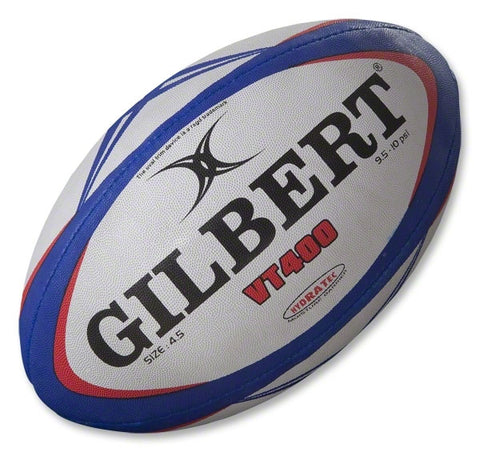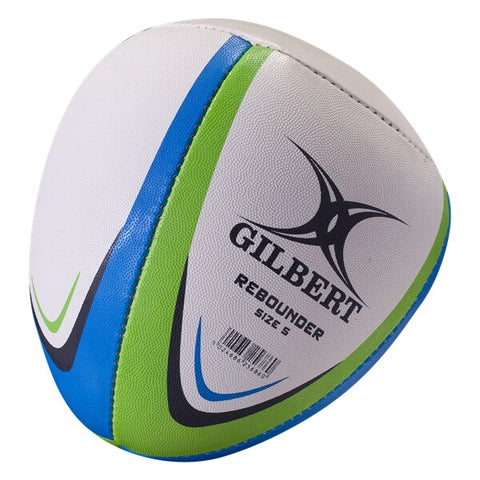Size and Shape
World Rugby requires that the official size 5 rugby ball be oval and made of 4 panels that are leather or a suitable synthetic material.
There are variations between ‘official’ balls, however, World Rugby allows balls to have a length in line between 280 and 300 millimeters, an end-to-end circumference of 740 to 770 millimeters, and width circumference of 580 to 620 millimeters.

The degree which the ends are rounded play a huge role in how the ball plays. In general, the more pointed the ends, the better the ball is for passing, but the more difficult to kick. More rounded ends are easier to kick and control, but more difficult and slower to pass.

Size 5 balls are the official ball used by both men’s and women’s teams in senior international competitions but is not the only size rugby ball. Smaller balls are available geared toward junior and youth rugby. The most common are:
- Size 4 [Length – 275mm (10.8 inches), Circ Length – 720mm (28.3 inches), Circ Girth – 555mm (21.9 inches)]
- Size 3 [Length – 255mm (10 inches), Circ Length – 680mm (26.8 inches), Circ Girth – 540mm (21.3 inches)].
Rugby Ball Grip
A textured ‘pimpled’ outer layer provides players with a true grip on the ball. The spacing, shape and depth of the pimples on the ball determines to a large extent how the ball performs. The grip on a rugby ball is carefully considered to balance between how easy a ball is to catch versus how far it can be passed or kicked.

Close-up of the textured ‘pimple’ pattern on the Gilbert Match XV rugby ball.
A higher pimple will generally give more grip but reduce kicking distance. The grip pattern can also affect how long the grip will remain on the ball. Lower profile, rounder pimples will last longer than higher, angular pimples but they will give less grip. This is why you will see different grip types for different types of rugby.
The needs of 15’s rugby is different from 7’s rugby, and even more different than those of touch rugby, with each game requiring different levels of kicking and passing.
Grip is also affected by the type of rubber used to make the ball. Natural rubber provides more grip and synthetic rubber provides greater durability. Generally match balls will have a higher ratio of natural rubber to synthetic rubber to provide better grip. Conversely, training balls will generally have more synthetic rubber, to provide a more durable surface compound.
A note on surface types and wet weather. In some cases higher end rugby balls (like the Match XV from Gilbert) use special compounds to perform better in wet conditions than non-treated balls. While this can make a difference, it is more important to consider the type of game being played before considering whether a ball is more designed for wet weather.
Panel Construction
How a rugby ball’s panels are constructed affects the shape retention, weight and energy transfer properties of the ball. Typically a panel consists of an outer layer where the rubber and grip are present, and a number of layers or ‘plys’ between the outer layer and the bladder.
Match balls are generally 3 ply in construction, and training balls are a mixture of 3 ply and 2 ply.
A 3 ply ball will weigh more, and be less affected by wind than a 2 ply ball, making it more ideal for kicking and long passing. A 3 ply ball will also generally hold its shape better than a 2 ply ball.
The materials used in the ply’s construction can also affect the way the balls respond to being kicked, especially in regard to how the energy is transferred into the bladder.
You will typically see three main types of materials used in the construction of the plys or “layers” below the outer cover. Cotton laminate, poly-cotton laminate, or some sort of polyester or other synthetic material laminate.
Cotton is cheaper than synthetic materials and is not as good at energy transfer (i.e. putting your kicking power into the ball) as synthetics. This is why you see increasingly more cotton construction in a lower quality of ball. The very best match balls have full synthetic ply construction using special energy transferring materials.
No matter how many or what type of plys are used, it is important that rugby balls be stored properly away from extreme hot/cold weather or the shape can be affected over time. Consistently over-inflating or sitting on balls can also alter their shape.
Bladder
The bladder is probably the most vital component in determining how a rugby ball performs. Bladders are available in different varieties and sizes, depending on the use of the ball. Traditionally, match and training balls use a natural latex bladder, which has high resilience, and provides a ball with good rebound characteristics. The downside of a natural latex bladder is that the surface is permeable, and allows air to pass through it, meaning that the balls need to be correctly re-inflated about once a week. There are advanced co-polymer bladders available, pioneered largely by Gilbert, which have equivalent resilience characteristics to natural latex, but that are non-permeable to air, therefore remaining inflated for much longer periods, sometimes upwards of 1-2 months.
Roughly speaking:
Natural Latex: Soft, bounces well, but leaks air (slowly).
Butyl Bladders: Offer an excellent combo of feel and air retention, typically in mid- to upper ranged balls*
Proprietary synthetics: Gilbert’s Air-Loc bladder is an excellent example of a co-polymer bladder that retains the qualities of natural latex without losing air. A more expensive material used in higher quality balls, but results in a ball that should hold air up to 1-2 months.
Valve shape and placement
The valve provides the means to inflate a Rugby ball, but also plays a key part in how the ball performs. The valve is essentially a weight that creates an imbalance. This can be used to either enhance or detract from the performance of the ball. If the valve is placed and constructed ideally, as in a high quality match ball, the rotation of the ball is improved which increases accuracy and distance of passing and kicking by improving the spiral action. In lower quality training balls, the valve can reduce the accuracy and distance when compared to a match ball, because the imbalance can offset the spiral action.
As a rough rule of thumb, match balls will have the valve placed in the seam of the ball, as this helps distribute the weight to most effectively improve rotation. Whereas training balls will usually have the valve in the middle of one of the panels, which creates a slightly more lopsided spin.
Pre-Kicking
You will sometimes see the designation, particularly on high end match balls, that a ball has been ‘Pre-Kicked’. While this may seem excessive, this helps the ball find its correct shape after inflation more quickly than a ball which has not been pre-kicked and also helps detect any defects in manufacturing. This is one more advantage of a premium match ball over other balls.
Match Ball

Match balls are designed for maximum performance as opposed to low cost and durability. They usually feature more natural rubber for improved grip, valves placed in the seams of the ball to improve spin and flight, more synthetic ply construction, and special internal bladders to further increase trueness of flight. There is a spectrum of match ball quality starting with those that are just a cut above training balls to those that are international quality.
Training Ball

Training Rugby balls are a very cost effective option for practices and low level game play or as an entry point for new players. They are designed with cost and durability in mind rather than maximum short term performance. Training balls tend to be made with more synthetic rubber which makes them more resilient but have less grip than match balls which use more natural rubber.
They also tend to have their valve on the panels as opposed to inside the seam as match balls do. This can cause the balls to not spin or kick quite as true as a match ball. Training balls will usually have ply’s constructed of more cotton as well.
These factors are not as important for practices where simply having enough balls is more important than having a few extremely high performing balls.
Sevens

Sevens rugby balls are designed to maximize passing and catching performance given the relatively small amount of kicking done compared to 15’s. As a result, the grip is usually very aggressive (high angular dots) and the ball has a slightly narrower, more “torpedo” like shape. This makes the ball easier to handle, but slightly more difficult to kick.
Women’s

Women’s specific balls are often either size 4.5, which is not legal for competition play, or are size 5 balls that are on the smallest end of the dimensions for a regulation ball. In the case of the 4.5 these are meant to help improve skill development for younger women in particular as younger women tend to have smaller hands than their male counter parts. This can make handling a full size 5 at a comparable age more challenging and some would contend harms skill development as a result (this is a contentious issue though). The regulation size 5’s for women are smaller for this same reason namely that women tend to have smaller hands and thus more difficulty handling the larger dimensions available in standard size 5 balls.
Beach
Beach rugby balls have a slightly soft, squishy surface designed to function properly even while wet and covered in sand. Beach rugby balls can also make excellent balls for young children and PE classes as they are much softer than standard rubber balls and can be less intimidating, easier to catch and potentially cause less damage if a child were to get hit in the head or face.
Weighted
Weighted rugby balls usually weigh in at around 2.2 lbs (1 kg). They should never be kicked as they can cause serious harm to your foot and ankle. The extra weight helps develop the muscles involved in passing and force you to use a more efficient and technically sound pass. They are most valuable for the latter in our estimation as it is very difficult to make a successful pass using poor technique.
Rebounders

Rebounder balls are effectively half rugby balls that still have the weight of a standard ball and let you replicate the same passing mechanics of a full sized ball without the need for a partner. These are excellent for individual skill work and developing your pass. They work well for standard spin pass as well as line out throws and even end on end kicks.
Promo Size 10 Rugby Balls
Giant promo balls have no practical purpose, but can be great ways to promote your team or grab attention at recruiting events. They vary in size but the most common size we run into are sized: Length – 420mm (16.5 inches), Circ Length – 1140mm (44.9 inches), and Girth- 880mm (34.6 inches).
